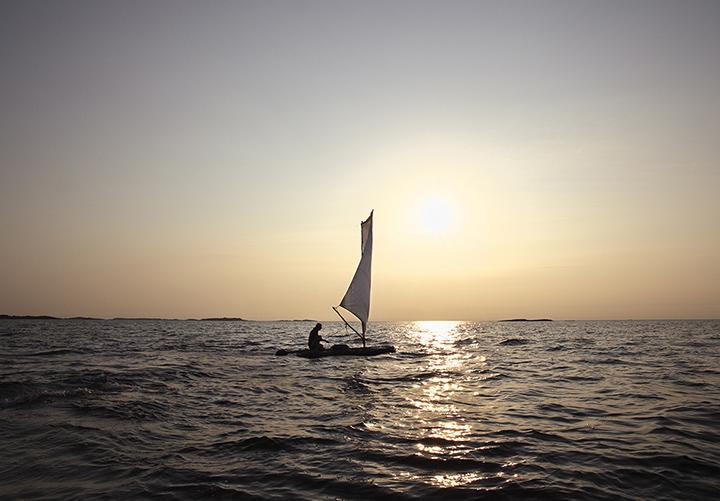Image credit: Antti Laitinen, Bark Boat, 2010. HD video still. Courtesy of the Artist.
Interview with Curator Kristy Trinier
Written by Lynda Vang
The highly anticipated exhibition, Survival Guide, opened on January 27, 2017. Curated by Kristy Trinier and presented as a part of the Poole Centre of Design, Survival Guide asks: How do we adapt and process current shifting political, economic, personal and environmental challenges to our safety and stability? We sat down with Kristy to discuss the inspiration around Survival Guide and how the exhibition resonates now more than ever in a time of global political uncertainty.
Q: Please tell us more about Survival Guide.
KT: The exhibition is about contemporary artists and the survival strategies represented in their works. This is to extend the conversation to the public at a time when people are very conscious of risk and instability in their lives as issues of survival are at the forefront in the news.
Q: Where did the idea for Survival Guide come from?
KT: I was definitely inspired by bush craft expert Mors Kochanski. I was interested in his research around the physical and medical effects of stress on the body in extreme environmental conditions and how the body can survive. Considering a scenario in the boreal forest with an absence of shelter, warmth, water—and if food isn't available, how do you get through that critical time period of the first forty-eight hours of survival? There are many artists who are also investigating relatable concepts of how we might survive extreme conditions through their work, so I felt there was a synergy there.
Q: The motivational theory of Maslow’s hierarchy of needs is referenced throughout the exhibition. How did Maslow’s hierarchy influence the curation of the exhibition?
KT: In thinking of the theme of survival, I referenced Maslow's hierarchy of needs. This was kind of an entry point to understand how one need predicates another in regards to survival. At the very bottom of the triangle of the hierarchy of needs you'll find the needs related to safety and physiological needs such as shelter, food, etc. and closer to the top are things like: social connection and psychological wellness. The conclusion of Maslow's research showed there is a base level of hierarchy but at your core, if you are not able to calm yourself or find a way to deal with psychological stressors than the stability of the basal needs can indicate risk again.
Q: Survival Guide has opened during a very contentious time–politically speaking, with many people feeling at risk at the moment—
Yes, there's a real resonance to these works right now. I feel that it's become increasingly urgent during the time I have been planning the exhibition. I feel like the statement the artists are making through their works shares a lot of coded information, including designs in how others survived before, that we might learn from. Ultimately, the exhibition is stating that survival is a collective practice—so even if you're on your own, the ways that we learn to survive are transmitted from those who have survived before and shared their knowledge—visually, through prints and illustrations, or even through performances that reference survival advice found within children's stories. All of this shared knowledge help inform us on how to get through times of stress or trauma.
I'm really grateful to the artists whose contemporary artworks are present in the exhibition because they speak to our time – and relate to the context of survival within Edmonton and the boreal region to the north of us but also relates to many other places around the world that are experiencing these types of stressors. The artists have been able to connect to those conversations right now and they have a lot to offer through their works.
Be sure to visit Survival Guide from January 28–May 7.
Survival Guide is organized by the Art Gallery of Alberta; curated by Kristy Trinier. Presented as a part of the Poole Centre of Design.








